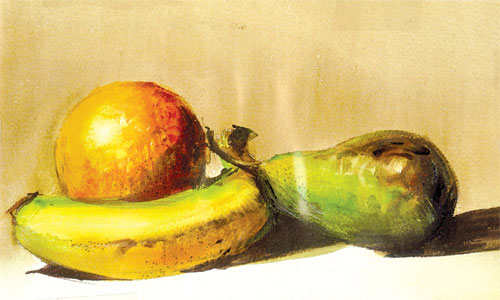|
Learn to draw by Tissa Hewavitarane
Still life of fruit
Still life is traditionally a picture which generates interest. It
can be practised from the moment you start painting with watercolours.
In this exercise we are going to develop important concepts related to
the technique and practice of the still life. To do a good still life
painting it is the first step to form a correct composition.
It depends to a great extent on the objects that make up the
composition. The model has to be prepared with care and the possible
composition techniques have to be thought out. A model with a variety of
colours and textures could be sought out so that different solutions to
take valuation could be worked out. First begin the work is began with a
plain sketch of shapes that you want to represent.

The fruit painting shown here is not complicated, it is done neatly
and with a lot of thought to put the exact colours. As a simple exercise
only three fruit are shown here.
Note the background of a broken tone of burnt sienna and light yellow
ochre is used to paint the background. To increase the brightness the
tone that surrounds the shape of the fruit is made darker.
The valuation of the orange is done with progressive tones of the
same colour where the highlight meets the shadow brushstrokes tinted
with red are made.
The painting of the banana is done with long brushstrokes in a
lighter green and yellow. Observe the valuation tones of the banana.
Before the green of the first brushstrokes are completely dry a golden
yellow is applied on the banana skin to give the ripened effect.
The direction of the brushstrokes has to follow the shape of the
banana and reduce the green until it softly merges with its contour. The
lower part of the fruit is given a shady colour of sienna and orange.
On the pear the shadow is painted with burnt amber and soft brush
strokes are made on the limits of the green until the tones are mixed up
well.
On the right of the pear shadow, on the dry background, long wet
brush strokes open up a soft area of light. Lastly to darken the banana,
the lower part is given a dark shadow colour.
As a light exercise for children we have done the complete modelling
of the three pieces of fruit. The drawing paper used is Kent paper 250
grams with slight grain and Nos. 2, 3, 6 and 8 soft sable hair brushes
used for colouring. |

